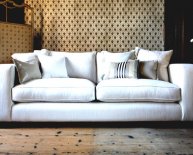We need to make sure that the customer is aware of the properties and characteristics of the fabrics. It is the designer's responsibility to select the appropriate fabrics for their intended applications, but it is the responsibility of the fabric producer to provide as much information as possible to help customers make appropriate fabric selections. Like physical porperties, style characterstics, tactile characteristics, utility characteristics, durability and so on..
Physical properties of Fabrics
Physical properties are the static physical dimensions of fabric. The following physical properties are used to define the static physical dimensions of strand fabrics:
Fibre or filament: type, size, length
Yarn: diameter, twist, weight or size, count, fiber content for mixed yarns, ply.
Weight: ounces per squared or yards per pound.
Thickness: vertical depth.
Fabric structure
Woven fabrics: weave type, warp and filling yarn count per linear inch
Knitted fabric: knit type, wale and course count per inch
Finishes: chemicals such as resins, starches, waxes and mechanical effects such as
Calendaring and napping applied to the woven fabric to yield or enhance style, durability, and utility values.
Fabric width: The length of the filling or course
Colour: Hue, value and intensity (degree of brilliance)
Fabric density: weight per unit of volume.
Surface contour: the geometric dimension of the surface plane.
Physical characterirstics of fabrics
Physical characteristics are the dynamic physical parameters of fabric. They are physical changes in the fabric that result from applying outside forces on the fabric. Most of the durability and utility values of fabric are characteristics and not properties.There are four major categories of fabric characteristics that interest the apparel manufacturer. They are:
Style characteristics
Utility characteristics
Durability characteristics
Product production characteristics
There are often correlations among the four types of characteristics. A utility characteristic such as fabric elongation will be correlated to a working characteStyleristic such as sewing without stretching.
Style characterisitcs of fabric
Style characteristics are those changes which affect the emotional appeal, the fabric imports to the consumer. This is exemplified when a consumer handles a fabric and refers to the fabric with adjectives such as stiff, soft, hand, etc. The three basic categories for style characteristics are:
Hand characteristic - are the changes of the fabric plane with hand manipulations, which exert tensile compression, molding, or supporting forces on the fabric. The hand characteristics include some of the utility characteristics, such as elongation, elasticity, flexibility, etc.
Tactile characteristics - refer to the changes in surface contour that result from a mechanical force exerted on or against the surface structure. These changes apply to the surface contour aspects of the fabric surface and not the fabric plane. The surface contour changes dimension under tactile pressure (no matter how small the pressure) this is a tactile characteristic. Pile, napped, and any fabric whose surface contour can be varied by tactile pressure, have obvious tactile characteristics.Designers specify tactile characteristics with terms such as soft, coarse, rough, hard, smooth sticky, oily and greasy.
Visual characteristics - are the changes in the colour values when either the fabric or light is moved. End – to – end shading, side - to – side shading and mark – off are three colour quality problems in addition to metamoric fabrics.
End – to – end shading - refers to changes in shade throughout the length; the shade of one end of the bolt differs from the shade of other end.
Side – to – side shading - refers to changes in shade from selvage to selvage; the shade of the fabric along one selvage differs from the shade of the fabric along the other selvage.
Mark – off - in fabric is the phenomena of changing the shade and/of intensity of the fabric surface by rubbing it.
Metamoric - fabrics exhibit colour difference with change in the spectral distribution(characteristics) of the illuminant
Utility Characteristics
Utility characteristics are changes in the fit, comfort, and wearing functions of the garment when the fabric engages a mechanical thermal, electrical, or chemical force during the utilization of the garment.The two major types of utility characteristics are transmission and transformation. A transmission characteristic transmits mass or energy through the fabric. Transmission characteristics include:
Air permeability ( includes all gases and vapour)
Heat transmission ( thermal conductivity)
Light permeability
Moisture transmission
Radioactivity transmission (the degree with which radioactive energy such as x – ray and gamma rays can penetrate fabrics).Transformation characteristics charge a physical property of the fabric. The property dimension(s) is altered without destroying the fabric. Changes which disintegrate the fabric are durability characteristics. Transformation characteristics include:
Colour fastness
Crease resistance
Crock resistance
Dimensional stability
Pilling
Shrinkage
Static electricity etc
Durability characteristics
Durability characteristics are the capacities of fabric to maintain the style and utility characteristics during wear. It is the measure of stress which destroys the fabric or the fabrics ability to repeat a desired style or utility characteristic.The durability characteristics are:
Abrasive strength (measure of rubbing action)
Bursting strength ( measure of vertical pressure)
Launder ability ( measure of washing)
Tearing strength
Moth resistance
Tensile strength
Radiation absorption strength (the rate at which radiation energy either disintegrate a fabric or destroys utility characteristics).
Fire resistance
Corrosive strength ( the measure of chemical action, acid or alkaline)
Dry cleaning durability ( the measure of dry cleaning performance)
Product Production working charateristics
Product production working characteristics are those characteristics which affect the quality of production with respect to quality values and the cost of production method.The working characteristics of a fabric include:
Coefficient of friction ( cutting, sewing, pressing and packing)
Sewed seam strength
Sewed seam slippage (yarn slippage)
Sewing distortions
Yarn severage
Bond ability strength (fused, cemented, and heat – sealed seams
Pressing moldeability (to what degree a flat piece of fabric may be skewed during pressing with hand and /press buck).
Source: www.textileschool.com


















